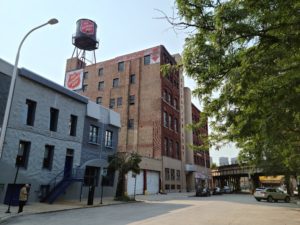
For the past 102 years, The Salvation Army Adult Rehabilitation Center (ARC) facility at 509 N. Union, Chicago, IL has provided a stable home and work environment to thousands of ARC beneficiaries, Salvation Army officers, and employees. In March 2022, the building passed to new owners and Chicago ARC operations consolidated at the Clybourn Avenue location.
Last summer, the museum staff received an invitation to explore the nooks and crannies of the 131-year-old historic building and collect items that demonstrate what it was like to live, work, shop, and begin a new sober life from this building. Staff found some great treasures for the museum’s collection including, plates and dining chairs, inspirational items and symbols of faith from long vacated workstations, charts of the clothing sorted for sale, directional signs, a foreman’s desk from the loading dock, and so much more. Unfortunately, the iconic water tower was just too big to fit in the truck. Among these treasures, one item stood out above the rest. It was a bicycle, a rather unusual one at that.
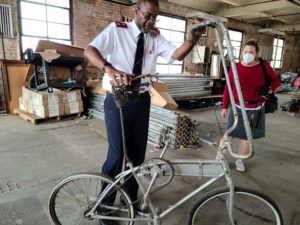
Located several floors up in the old workshop, a bicycle seemed out of place alongside old trunks, broken furniture, tools, and workbenches. The wood seat and aluminum tube frame handlebars were even more unusual. ARC Administrator Major KK Mathews, Curator Jolie Diepenhorst, and I spent a good amount of time looking at the bike trying to understand its purpose. Did that strange handlebar once hold an advertising sign? Or, maybe it once held a basket or bag of some sort?
The bicycle has now made its way to the museum. I have examined it closer and conducted thorough research to learn how it likely looked when first built and how it evolved. Thanks to the wealth of collectors who create websites and chatrooms to share photos and knowledge about their collected treasures, digitized advertising materials, manufacturer catalogues, corporate histories, online newspaper archives, and the digitized holdings of the Library of Congress, research that once would have taken months or years is now completed in a fraction of the time.
This bike lived at least two lives: one as a traditional bicycle and another as the masterpiece of its creator. It was originally made in Chicago sometime between the late 1930s through the 1940s by the Manton & Smith Company, which advertised in the yellow pages that they were “Manufacturers of bike-lock protected bicycles.”
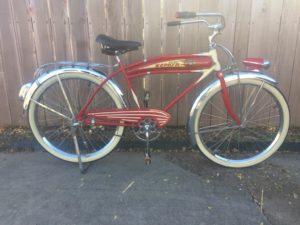
Founded as an ironwork company, Manton & Smith contributed to Chicago’s iconic Buckingham Fountain and skyline. In the 1920s, they began producing bicycle frames for other companies to brand as their own product. Additionally, they released their own line of bicycles from the late 1930s through 1953, when the company dissolved. One of the companies they sold frames to appears to be the Standard Bicycle Company, located at 1413 S. Michigan Avenue.
This bike was Manton & Smith’s Golden Zephyr model, an ordinary cruiser-style men’s bike that was typical for the era. The frame features gently curved top and secondary tubes. This was a high-end model as demonstrated by the integrated “Bike-Lok” system in the head tube. When engaged the lock prevents the bike from steering or moving forward, deterring theft. The angles of the two top tubes, long frame lines, design of the locking mechanism, and a small patch of the original bright red paint located under the bike, point to Manton & Smith as the original manufacturer. The head badge bears the name “Standard” in red that is barely visible through thick, chipping silver paint. Additional badge markings of “Standard Company” and “Chicago Illinois” provide further clues.
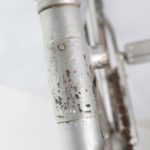
The Standard Bicycle Company also has its own place in cycling history. The company was founded in the early 1930s and operated through at least the 1950s. A bicycle wholesaler and distributor to Chicago area dealerships, Standard Bicycle Company also sold new bikes directly to customers. A 1938 yellow page listing noted the scope of the business as “Whol. Dist. Dealers Write for Cat. Monarch, Excelsior & Manton-Smith, Velocipedes & Accessories.” Together, Manton & Smith and Standard Bicycle were two businesses that helped make Chicago the “Detroit of bicycles” during a short period of the twentieth century.
Around the early 1990s, a new cycling scene began to develop in Chicago. Alternately called freakbikes, ratbikes, or frankenbikes, practitioners combined parts from multiple bikes to make a creation all their own. These functional art pieces may be used as a daily commuter or ridden for special occasions. During this time, the Standard bike took on a whole new life and carefully adapted into the machine we see today.
The drivetrain was removed. The entire bottom bracket was cut off, crankset and all, from another early (possibly pre-WWII) bicycle and mounted between the two top tubes. It was braced with a wood block and secured with metal straps. The original housing for the crankset now features a piece of wood to help give the rider a boost into the saddle. Based on the distance between the seat and pedals, the person who built this bike was probably 5 foot 7 inches and 5 foot 10 inches tall. The handlebars were bent upright and joined with another inverted pair to form the distinctive curved rectangle shape. A long piece of metal tubing forms the high riding seat post and is attached to the original Troxel Company saddle. The leather seat covering has long since rotted away. While the key to that nifty head tube lock mechanism is long gone, this bike is still going nowhere. A heavy wire, possibly from a coat hanger, has been inserted through the rear wheel, possibly as a DIY bike lock. Lastly, the bike received a few coats of silver paint. As the coffee or cola stains on the frame suggest, this tall bike was ridden frequently.
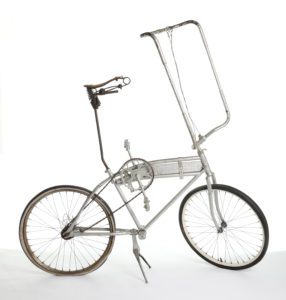
As we see it today, it is unlikely the bike was a donation to the Family Store on the first floor of the building. While we may never know who built this freakbike, the fact that it was found high up in a workroom of the Chicago Central ARC building suggests it was made and used by a man who once worked in the shop. A shop worker would have had access to all the tools and materials at their disposal to build this bike. We now have some of those tools in the collection.
Every trash day, Chicago alleys and local bike shops like Working Bikes provide accessible and affordable bikes ready for transformation by the Chicago freakbike community. If they didn’t have bike building knowledge books like Atomic Zombie’s Bicycle Builder’s Bonanza by Brad Graham and Kathy McGowan provide the freakbike artist with step-by-step directions on how to create their one-of-a-kind masterpiece. The maker of this bike intentionally sourced mid- twentieth century bikes parts for the creation, based on the types of parts used.
ARC beneficiaries enjoyed hobbies at the 509 N. Union facility. It was evident through the lasting remains of their interests found throughout the building. Neisha McNeal, Director of Program for the ARC Command, noted that it isn’t unusual for beneficiaries to create things and leave them behind when they depart. This remarkable bike is likely one piece of someone’s Salvation Army ARC story.

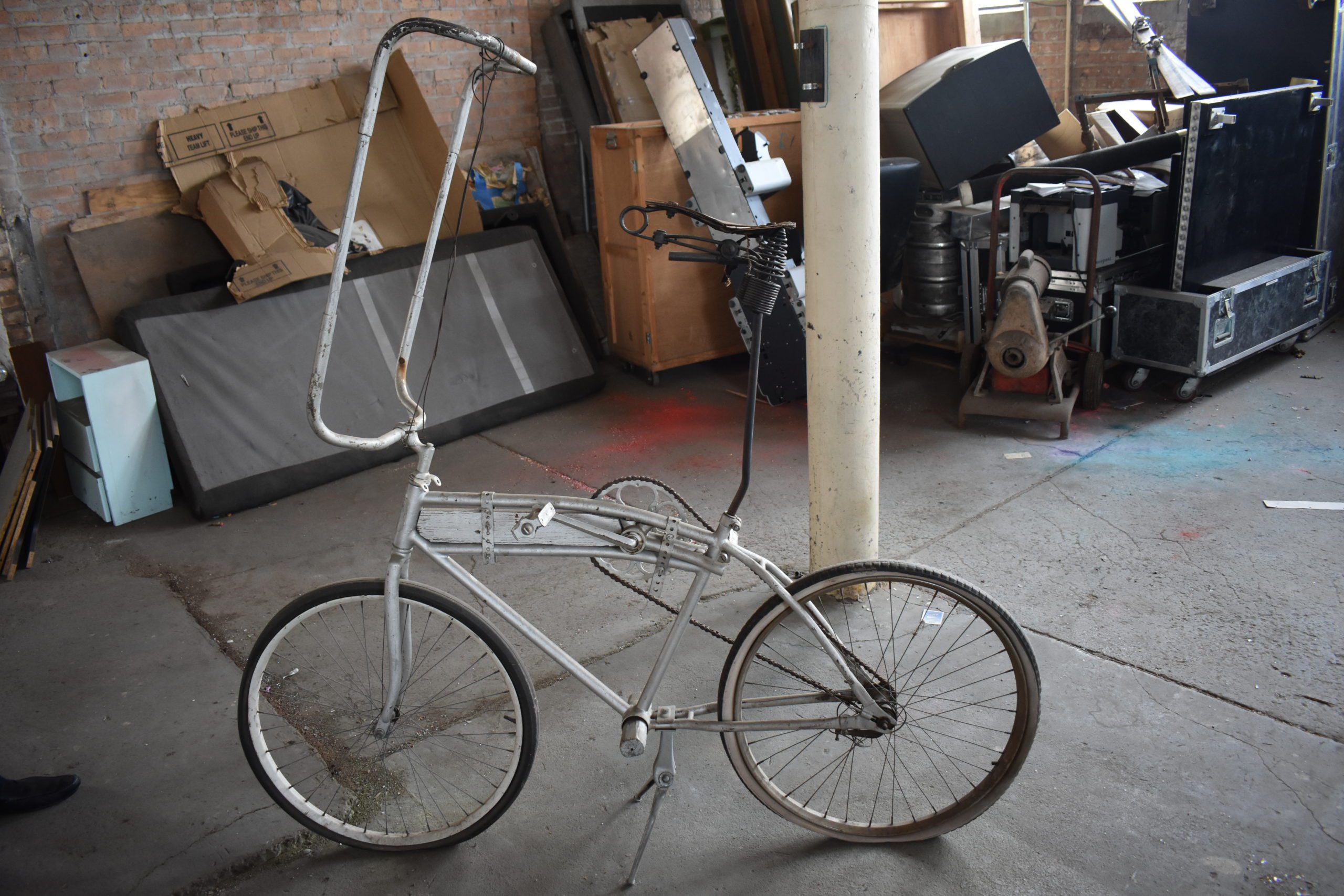
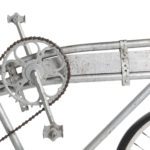

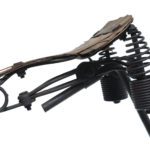
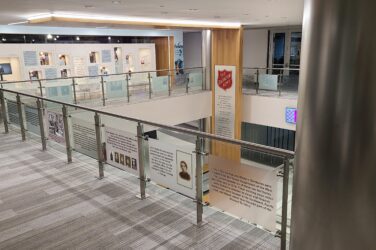


Show Comments